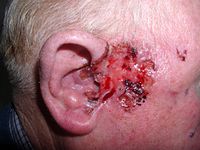
Photo from wikipedia
Renal cell carcinoma (RCC) is a heterogeneous disease comprising a variety of histological subtypes. Approximately 70–80% of RCC cases are clear cell carcinoma (ccRCC), while the remaining subtypes constitute non-clear… Click to show full abstract
Renal cell carcinoma (RCC) is a heterogeneous disease comprising a variety of histological subtypes. Approximately 70–80% of RCC cases are clear cell carcinoma (ccRCC), while the remaining subtypes constitute non-clear cell carcinoma (nccRCC). The medical treatment of RCC has greatly changed in recent years through advances in molecularly targeted therapies and immunotherapies. Most of the novel systemic therapies currently available have been approved based on ccRCC clinical trial data. nccRCC can be subdivided into more than 40 histological subtypes that have distinct clinical, histomorphological, immunohistochemical, and molecular features. These entities are listed as emerging in the 2022 World Health Organization classification. The diagnosis of nccRCC and treatments based on cancer histology and biology remain challenging due to the disease’s rarity. We reviewed clinical trials focused on recent discoveries regarding clinicopathological features.
Journal Title: Biomedicines
Year Published: 2022
Link to full text (if available)
Share on Social Media: Sign Up to like & get
recommendations!